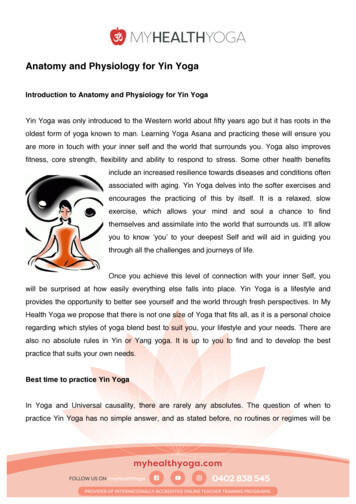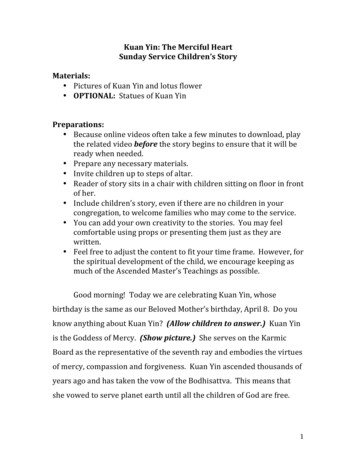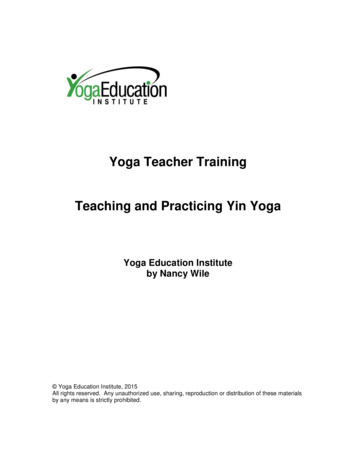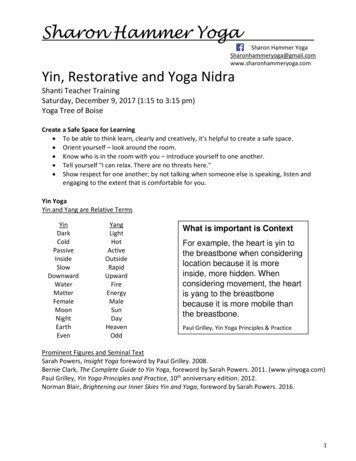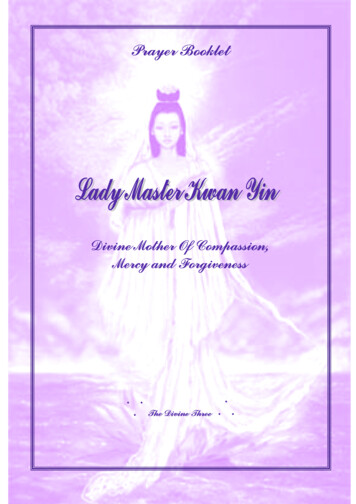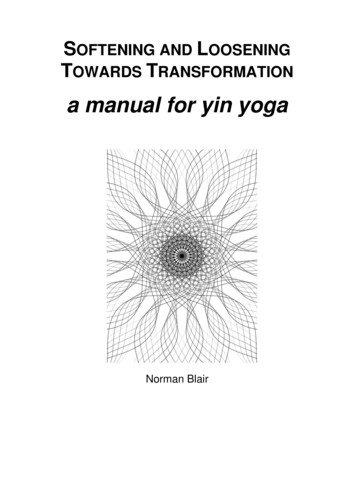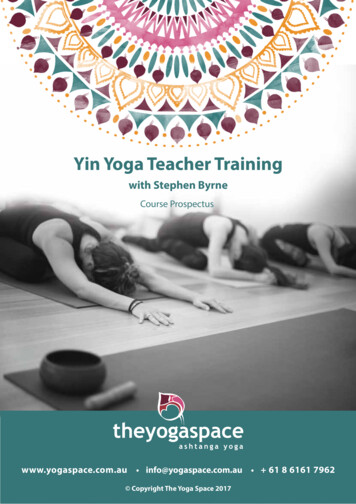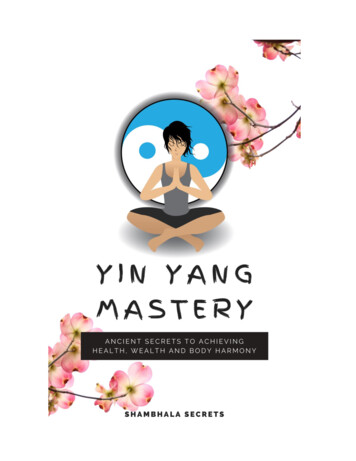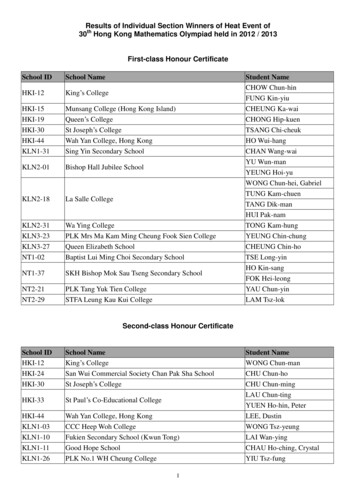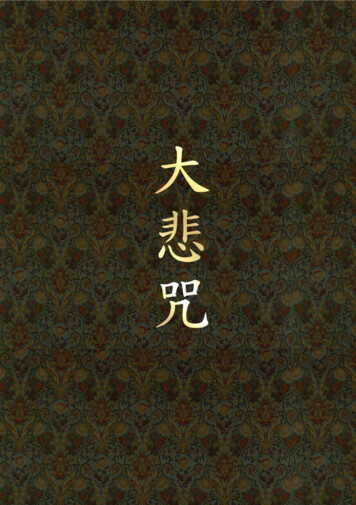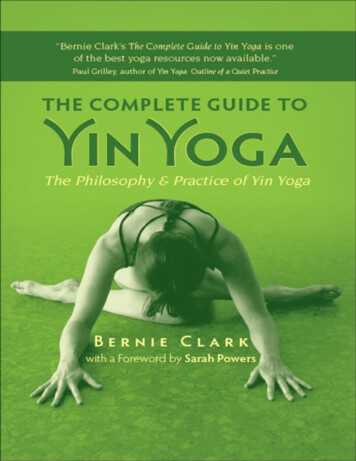
Transcription
THE COMPLETE GUIDE TOYIN YOGA
THE COMPLETE GUIDE TOYIN YOGAThe Philosophy and Practice of Yin YogaBERNIE CLARKFOREWORD BY SARAH POWERSWHITE CLOUD PRESSASHLAND, OREGON
All rights reserved. Copyright 2012 by Bernie Clark. No part of this book maybe reproduced or transmitted in any form or by any means whatsoever, includinggraphic, electronic, or mechanical, including photocopying, recording, taping, orby any information storage or retrieval system, without permission from thepublisher. Inquiries should be addressed to: White Cloud Press, PO Box 3400,Ashland, OR 97520. Website: whitecloudpress.comCover and interior design by Confluence Book ServicesLibrary of Congress Cataloging-in-Publication DataClark, Bernie, 1953The complete guide to yin yoga : the philosophy and practice of yin yoga / byBernie Clark.p. cm.Includes bibliographical references and index.ISBN 978-1-935952-37-41. Yin yoga. I. Title.RA781.73.C53 2011613.7'046--dc232011028908Credits for Art and PhotographyChapters 2, 3, & 4: Photographs of Cherise Richards, our Yin Yoga model, are by Christy Collins.Copyrighted 2011 by Bernie Clark.Chapter 6: p. 195: “The Myofascial-Tendon Complex,” reprinted, by permission, from SEER TrainingModules, Structure of Skeletal Muscle. U. S. National Institutes of Health, National Cancer Institute. tructure.html ; p. 196: “Collagen Fibers,” reprinted, bypermission, Matthew P. Dalene and the Rensselaer Plytechnic Institute; p. 201: “Connective Tissues,”reprinted from Gray’s Anatomy, 38th Edition, The Anatomical Basis of Medicine and Surgery Copyright, p.76, by Pearson Professional Limited 1995 and with their kind permission; p. 208: “Types of SynovialJoints,” reprinted, by permission, Produnis of the Wikimedia Share Commons.Chapter 7: p. 256: “The Cell’s Cytoskeleton” from Energy Medicine—The Scientific Basis, p. 46, copyright
Elsevier Limited, 2000, reprinted, by permission, from Elsevier and James Oschman.
For Nathalie, who has come toshare in my belief that yin is truly in!
Table of nChapter One: Yin Yoga DefinedYin and YangYin Tissues and Yang TissuesThe Theory of ExerciseOriginal YinDaoist YogaModern YinstersChapter Two: The Practice of Yin YogaHow to Practice Yin YogaIntention & AttentionMoving EnergyChapter Three: The Asanas of Yin YogaAnahatasanaAnkle StretchBananasanaButterflyHalf ButterflyCamelCat Pulling Its TailCaterpillar
Child’s PoseDanglingDeer PoseDragonsFrogHappy BabyReclining TwistSaddleShoelaceSnailSphinx & SealSquareSquatStraddle (Dragonfly)Swan & Sleeping SwanToe SquatShavasanaYin Yoga Poses for the Upper BodyYang CounterposesChapter Four: Yin Yoga FlowsAn Easy Beginner’s FlowA Flow for the SpineA Flow for the HipsA Flow for the LegsA Flow for the Shoulders, Arms and WristsA Flow for the Kidney and Urinary Bladder Meridian LinesA Flow for the Liver and Gall Bladder Meridian LinesA Flow for the Stomach and Spleen Meridian LinesA Flow for the Whole BodyWall YinChapter Five: Special SituationsHip & Knee IssuesLower Back DisordersHaving Babies
Chapter Six: The Physical BenefitsStressing our TissuesFasciaConnective TissuesJointsOther Physiological Benefits of Yin YogaChapter Seven: The Energetic BenefitsA Yogic ViewA Daoist ViewA Western ViewChapter Eight: The Heart & Mind BenefitsBibliographyIndexAbout the Author
ForewordThe practice of yoga has always been evolving, but essentially yoga is thecultivation of attention. What we attend to and the attitude with which weattend greatly influence how we experience ourselves and our life. In yoga weconcentrate on both form (our bodies and tissues), and formlessness (our breath,energy channels, and mind states). These interconnected aspects of reality are inconstant interplay, they are the Yin and Yang of life, and, in yoga we developand balance these polar complementarities within our body/mind experience. Formost of us, beginning with that which is most tangible, the body (Yang) is acommon doorway into the practice. As we become less distracted and healthierphysically, most students eventually become interested in that which is morehidden. This can be called the yin aspect of reality, which relates with that whichis subtle. It is only by paying attention in a relaxed and attuned way that this yinaspect of yoga is revealed.When students first begin a yoga practice, perhaps to reduce stress or to get inshape, or maybe just to accompany a friend, they will often be guided to placethe largest percentage of their attention on the shape of the poses they are tryingto do. This keeps the practice safe and as we learn postural integration, our bodybased experience becomes more joyous, healthy, and the postures more fun toinhabit. Eventually, with skillful guidance, sincere practitioners becomeinterested not only in the outer forms of yoga, but in the inner revolution thatyoga can offer, or, as Bernie might say, they start to go yin-side. It is here that thedeeper aspects of yoga are revealed.Paying attention to the fluctuations of the breath, noticing the sensationsebbing and flowing in the physical body, tracking the changing feelings in theemotional body, and recognizing the space of the mind as well as the thoughts inthe mental body are all part of yoga. This yoking or joining of the body, heart,and mind provides health benefits beyond simply being more flexible orstronger. The word health is derived from an Old English word meaning“whole.” Yoga re-establishes our natural wholeness — the balanced integrity of
our yin and yang nature.Adding a yin or quieter aspect to our yoga practice can introduce us to thepossibility of physical/emotional/mental equilibrium by marrying the softer,contemplative modes of being in life to the stronger activities we are so oftencompelled by. This helps reduce the compulsive extremes of behavior that causeus to lose balance, lose focus, and diminish our joy of living. Yang energy isneeded to bring vitality to our yin interior, but it is the gentler yin qualitieswithin us that balance our yang intensities. If you have felt that life is too oftennot how you would like it to be, then learning the ancient art of deep listening,tuning in to the internal, non-conceptual, softer aspects of your yin nature maybe the healing direction.Yin Yoga, when taught skillfully, can provide this opportunity to go withinand re-align our orientation. It will also affect our physical body in ways thatmay surprise us. It is simple, but often challenging. It will provide us with ampleperiods of stillness within which we can start to pay attention to what is reallyhappening, right here, right now. It can provoke insights that may move us tomake significant changes in our life or allow us to accept that what is happeningright now is exactly what ought to be happening right now. We may discoverourselves opening up to and connecting with our experience as it is, rather thanholding on to resistance and feelings of victimization.For anyone seeking to learn and benefit from the practice of yoga, this bookwill be an invaluable guide. Bernie has been a student and friend of mine formany years. I know him to be a thoughtful and dedicated teacher who has helpedmany through his workshops, website, and writings. Through this book, he issharing his own practice for all our benefits, seeking to help anyone who desiresgenuine health and wholeness. Within these pages, you will find explorations onthe physical benefits of Yin Yoga and explanations on the ways Yin Yoga helpsus energetically as well as emotionally and mentally. The practice of Yin Yoga isdescribed in detail and the various asanas are reviewed in a simple way,allowing them to be fully experienced. For those interested, the evolution ofyoga in general and Yin Yoga specifically is also presented.It is with heartfelt encouragement that I invite you to experience openingwithin through the study and practice of Yin Yoga.Sarah PowersNew YorkSeptember 2011
PrefaceMany readers of my previous book, YinSights: A Journey into thePhilosophy & Practice of Yin Yoga, wrote to tell me how much theyenjoyed reading it and how valuable they found the practice of Yin Yoga. Alongwith many emails, there were also requests posted in the YinYoga.com Forumasking for even more information: how to get into the poses described in thebook and how to safely come out of them, how to do Yin Yoga for the upperbody, whether Yin Yoga would be helpful for unique, special situations, and lotsof other questions. Many readers asked about the Daoist history that alsoinformed and influenced the development of Yin Yoga. The demand grew for asecond edition of YinSights that would cover these and other details of thepractice of Yin Yoga.Unfortunately, a technical challenge arose: adding to the information alreadypresented in YinSights would make the book unwieldy. YinSights was alreadyover 400 pages long and extending it to answer all the questions being raisedwould make the book too bulky. A second edition did not seem like a good idea.Fortunately the opportunity arose to solve this problem by creating, not a secondedition of YinSights but a new book focused more tightly on the practice of YinYoga and its benefits and less on the philosophy and evolution of yoga ingeneral. The result is what you are reading right now.The Complete Guide to Yin Yoga borrows heavily in many places fromYinSights, but it extends what was presented in the earlier book considerably.Yinsters familiar with YinSights will find a few sections repeated entirely butthey will also find an expanded description of the Yin Yoga postures, more flowsfollowing broader themes, and postures designed to work the upper body.Special situations are also covered, such as how to modify your Yin Yogapractice if you are pregnant or what to do to help you become pregnant. There isa more complete examination of the effects of Yin Yoga on our fascia and alsoon our muscles too.Of course the benefits of Yin Yoga go far beyond the physical, and this book
will also describe the considerable mental, emotional and energetic benefits wecan receive through the practice of Yin Yoga. I hope previous readers will enjoyThe Complete Guide to Yin Yoga as much as they did YinSights and that newreaders will be inspired to take a walk on the yin-side. After all, yin is in!
AcknowledgementsShowing the way fearlessly and compassionately,the stream of all our Ancestral Teachers,to whom we bow in gratitude.From Touching The Earth, A gatha of themonastics of Plum Village, FranceWriting a book begins as a solitary endeavor, but never one that startswithout encouragement. Along the way, through all the stops and starts,friends appear who give us the strength to continue. There are many people Iwish to thank for helping make this guide a reality. Firstly, I would like to thankSteve Scholl and Paul Grilley for suggesting the project in the first place. Ofcourse I would not even be in a position to write about Yin Yoga if it were notfor all my teachers, to whom I bow in gratitude.My eternal thanks to my first Yin Yoga teacher, Sarah Powers, who helped meunderstand how to slow down and mindfully practice yoga. Pranams to PaulGrilley who introduced me to so many of the concepts presented in this book; toJim Clark, for keeping me straight on the science.I would also like to single out the White Cloud Press team who contributed soimportantly to the work: to Raina for her tireless and excellent editing, to ChristyCollins for her photography, design and layout, to Cherise Richards for posingagain and again, and to Stephen Sendar and Steve Scholl for their patience. Ithank also Pilar Wyman for her indexing help.Finally, my blessings and thanks to all the students who have allowed me thehonor of teaching them: the best way to learn a subject is to try to teach it.Indeed, my students have been my greatest teachers.
Please Note! Before embarking on this practice,please make sure you are able to do so: check withyour doctor or health care professional beforestarting any yoga practice. The guidance given inthis book is not meant to replace medical advice andshould be used only as a supplement if you areunder the care of a health care professional. Whilecare has been taken in compiling the guidance in thisbook, we cannot take any responsibility for anyadverse effects from your practice of yoga. Whenyou are not sure of any aspect of the practice, or feelunwell, seek medical advice. Please read thecontraindications for each pose before you try thepose, so that you will know if this particular postureis a good one for you to try. Be aware of the manyoptions available to make each pose moreaccessible. Practice with both intention andattention.
IntroductionModern yoga has sprung from a figurative forest of many different styles ofyoga with many varied intentions. In the earliest records of ancient India,yogis were mythical beings with powers that could transcend this physical realm.One particular tree germinating in this fertile forest about 1,000 years ago iscalled Hatha Yoga, which means the forceful yoga. Hatha Yoga, distinct from theother trees in the yoga forest, was primarily designed to strengthen the body andprepare it for other forms of yoga; these forms could be the meditative practicesthat lead to liberation and enlightenment but Hatha Yoga could also be a pathtowards developing darker arts and black magic. Many Hatha yogis were famedfor their prowess as warriors and were hired as mercenaries.Today, we mostly know of Hatha Yoga in the West as the practice that makesus healthier and calmer. Not too many practitioners of yoga today are aiming forspiritual awakening, although if that happens, that might be nice. The intentionsfor attending a yoga class today may range from seeking health to seekingcompanionship. The fact that you can actually take a yoga class today is verynew: there were no classes in ages past—you learned by sitting at the feet ofyour guru. If you were lucky, he would impart to you everything he learned fromhis guru, but this transmission would take many long years of dedicated studyand practice.The Hatha tree sprouted many stout branches. Far more than the physicalpostures, or asanas, the original practice emphasized the breath and magic circlesformed by the hands and body, called mudras. In the last 100 years, asanas havemoved into the spotlight in the evolving Western versions of Hatha Yoga. Thereare dozen of branches now: some of the oldest are called Ashtanga Yoga,Iyengar Yoga, and Sivananda Yoga while some of the newest and smallest shootshave names like aqua yoga, dance yoga and wine & chocolate yoga. Most ofthese modern forms of Hatha Yoga emphasize health and wellness physically,mentally and emotionally.With the modernization of Hatha Yoga, some things have been lost. The
original forms of Hatha Yoga equally emphasized strong muscular activities,which can be characterized as yang practices, and the softer activities thatopened our deeper tissues such as the joints, which can be characterized as theyin practices. The yin-side of yoga is found now only hidden inside a few softerstyles such as restorative yoga and in the meditation practices, which very fewpeople are drawn to. This is an unfortunate omission because it robs the studentof the chance to develop enhanced health for the whole body, heart and mind.This book is an investigation into that missing half: Yin Yoga. Theinvestigation will take you into the philosophical underpinnings of yin versusyang and will explain the benefits of adding a yin perspective to your yogapractice. These benefits are considerable and are found in all aspects of our life:from our physical well-being to our mental and emotional well-being.The practice of Yin Yoga is explained here in detail, but a book is never asubstitute for a teacher. If you are drawn to investigate this part of the Yogaforest further, you are encouraged to seek out a Yin Yoga teacher that you canrelate to. Like all yoga practice, theory alone is insufficient: you must actually dothe practice. It is entertaining and educational to read about how and why youmight do Yin Yoga, but the real value comes in actually getting down on thefloor. So. . .as you begin to read this book, get off your couch, get out of yourchair, place a cushion on the floor and begin to read while sitting, or lying on theground. Move around all you want, but stay on the floor for as long as you can.You are already beginning the practice.
CHAPTER ONE Yin Yoga DefinedOur goal in life is not to become perfect: our goal is to become whole.Modern yoga has its roots deep in Eastern mysticism, has been fertilized bynineteenth-century gymnastics and wrestling, and has been shaped byWestern sensibilities. Today, yoga as practiced in the West is totally unique: thisyoga has never existed anywhere else before—today we practice Western Yogafor the benefits that Westerners desire. These benefits are considerable and willbe explored in this investigation. If you have been doing yoga for a while now,you might be experiencing only half of the practice and just some of the benefitsthat are available to you. Yin Yoga is the other half.Most forms of yoga today are dynamic, active practices designed to work onlyhalf of our body, the muscular half, the “yang” tissues. Yin Yoga allows us towork the other half, the deeper “yin” tissues of our ligaments, joints, deep fascialnetworks, and even our bones. All of our tissues are important and need to beexercised so that we can achieve optimal health and vitality.Exercise our joints?! Isn’t that dangerous? Yes and no. It depends on how wedo it; we can exercise our joints safely if we do so intelligently. If doneincorrectly, we can definitely hurt ourselves, but we can say that about any formof exercise.Saying that Yin Yoga is the other half, that it works the deeper tissues of thebody, is just the beginning of defining what Yin Yoga is all about. We need tolook at the definitions of the underlying principles of yin and yoga to look at theintention behind engaging in a yoga practice, and to explore the benefits andmethodologies used in a Yin Yoga practice.There are many reasons for beginning a yoga practice; obtaining optimumphysical health is just one. Many people are drawn to yoga to help reduce the
effects of stress in their lives. others wish to deepen their meditation practices orto simply become more present in their daily lives. As we will discover, yoga ingeneral and Yin Yoga in particular provides physical, mental, emotional, andenergetic benefits and, for some, spiritual. Which benefits you enjoy will dependgreatly upon your intention when you practice.How you practice is just as important as what you do in your practice. There isa yin aspect to life and a yang aspect. There is a yin way to practice yoga and ayang way that go beyond the actual movements and postures employed in a yogasession. Yin is yielding, allowing, and nourishing. Even within an active, sweatyyang practice we can adopt a yin sensitivity that will help us gain much morefrom our yoga practice. Even within an active yang lifestyle, we can adopt a yinawareness and acceptance that will help us gain contentment in our lives.Yin Yoga can have the same goals and objectives as any other school of yoga.What we do will be different but how we do it will be the biggest difference.Why we do yoga really comes down to our own unique, particular intentions.Knowing the benefits of the Yin Yoga style will help you clarify intentions foryour practice.Some students initially find this style of yoga quite boring, passive, or soft,but they quickly discover that it can be quite challenging due to the long durationof the poses. Yin Yoga is simple, but simple does not mean easy. We can remainin the postures anywhere from one to twenty minutes! After you haveexperienced this, even just once, you will realize that you have been doing onlyhalf of the asana practice.Please Note! Yin Yoga as described here is not restorative yoga. If the tissuesyou are targeting for exercise are damaged in some way, please giveyourself a chance to heal before resuming your regular practice.Yin and YangPatterns define our lives. Look around you right now and you willnotice the patterns surrounding you. Look up; you will see things thatare high. Look down; you will see things that are low. Listen; you will hearthings close by, and you will hear things far away. Bring your attention inward;you may feel the tip of your nose or the top of your head. Now you may befeeling the tips of your toes. Up, down near, far these are just some of the
adjectives we can choose to describe the patterns of life, of existence. Allpatterns are formed by contrasts. The pattern on a chessboard is formed by thecontrast of dark and light. The pattern of your life, when reflected upon, hasdisplayed a contrast of good times and bad. For the Daoist, harmony and healthare created when conditions arise where the contrasting aspects are in agonTigerPlasticElasticBalancing is not a static act. Imagine the typical depiction of weighing scales:two plates held by a common string suspended at a point halfway between them.When two equally weighted objects are placed upon the scales, there is a slightswaying motion, like a pendulum. If one side is too heavy, the scales tip andbalance is lost. When both sides are equal, there is still a slight oscillation aroundthe middle position. This rebalancing is the return to wholeness and health.The ancient Chinese called this middle that we return to the Dao.1 The Dao isthe tranquility found in the center of all events, and the path leading to thecenter. The center is always there even if we are not always there to enjoy it.When we leave the center we take on aspects of yin or yang.Yin and yang are relative terms: they describe the two facets of existence.
Like two sides of one coin, yin cannot exist without yang, nor yang without yin.They complement each other. Since existence is never static, what is yin andwhat is yang are always in flux, always changing.The ancient Chinese observed that everything has yin or yang attributes. Theterms existed in Confucianism and in the earliest Daoist writings. The yincharacter refers to the shady side of a hill or stream. Yang refers to the sunnyside. Shade cannot exist without light, and light can only be light whencontrasted to darkness. And so we see how, even in the earliest uses of theseterms, patterns are observed.There is no absolute yin or absolute yang. A context is always required: in thecontext of light, darkness and brightness define yin and yang. In a number ofother contexts, yin describes what is relatively denser, heavier, lower, morehidden, more yielding, more feminine, more mysterious, and more passive. Yangdescribes the opposite conditions: what is less dense, lighter, higher, moreobvious or superficial, more masculine, and more dynamic. The table shows amore complete list of comparisons. There is no limit to the relative contexts inwhich yin and yang can be applied.Yin Contains YangLook again at the symbol for yin and yang at the beginning of this section. Doyou see the white dot within the dark paisley swirl? Even within the darkness ofyin, there is a lightness of yang and vice versa. in the context of temperature wesay that hotter is yang and cooler is yin; but hot water is yin compared to boilingwater, which is yang. in the other direction, cold water is yang compared to ice,which is yin.In our yoga practice there are very active asana workouts, which we may callyang, but even within these yang practices we can find yin aspects; watching ourbreath mindfully while we flow through a vigorous vinyasa2 is just one example.Yin Becomes YangJust as we detect yin elements within the yang aspects, we can also notice howyin becomes yang, and yang can transform into yin. These transformations maybe slow and subtle, or they may be devastatingly quick. The seasons roll slowlyby, changing imperceptibly. The yang of spring and summer transforms day byday into the yin of fall and winter. it is not possible to pick the exact moment at
which one season becomes another, astronomical observations notwithstanding.But the transformation may also come quickly: the eye of a hurricane quicklybrings calm, and just as quickly the eye moves on and the other half of the stormstrikes.In our own life we often experience both the slow and quick transformationsof yin into yang and yang into yin. We wake up in the morning; yin becomesyang. Sometimes our awakening is slow, leisurely; this is a slow transformation.Sometimes we wake with a start and jump out of bed, perhaps because weoverslept. When we work long hours for many weeks or months in a row (a veryyang lifestyle), our body may seek balance by suddenly making us too sick towork (a very yin lifestyle), or it may gift us with a severe migraine to slow usdown. Yang is quickly transformed into yin.Yin Controls YangIn this last example, we can see that if we stay too long in an unbalancedsituation, the universe acts to restore balance. It throws us to the other side: ourhealth may suffer and our lives may change. If we do not heed the need forbalancing yin and yang, this transition can be devastating. A heart attack couldbe the balancing force applied to us. These imbalances are often referred to as anexcess or a deficiency. We can have an excess or a deficiency of either yin oryang. The cure is to apply the opposite energy to control the imbalance.In the Eastern world of the yogis3 of India and the alchemical Daoists ofChina, the need for balance is well known and understood.4 In the West, whilewe do not use the terms yin and yang, the need to pay attention and balance ouropposing natures has been realized by many astute observers of ourpsychological landscape. Carl Jung recognized his dark side, which he termed“the shadow,” and discovered that if left unattended, these dark, repressedenergies will wreak havoc in one’s life. The oppositions within create a dynamictension that can lead to destruction or amazing creativity. For Jung, the way towork with these opposing energies is to integrate them, or individuate5. He, andhis followers after him, developed many tools to do this integration. Shadowwork can include active imagining or creating rituals that honor both energieswithin us.SPIRITUAL PRACTICAL
ChoiceEcstasySobrietyVisionFocusLess is moreMore is betterNotice the differences and the similarities between the earlier table of yin andyang characteristics with the table on the previous page, taken from RobertJohnson’s6 book Owning Your Own Shadow. Here, Johnson shows the manyopposing values we are subjected to in Western cultures:7 one set our religious orspiritual beliefs require of us, and the other set is what we need to survive andthrive in our secular life, the business world. Note the yin-like qualities and theopposing yang-like energies. How we reconcile the opposing energies of Sundaymorning versus the rest of the week will lead either to a breakdown or abreakthrough; a revelation—which is only possible if we do the work required, ifwe do our yoga whether with Western or Eastern techniques.In the West, true understanding of yin and yang is uncommon. We don’t thinkin these terms; our lifestyles rarely reflect the need for balance. We seek it onlywhen the universe forces us to pay attention, when we suffer the breakdown thatavoiding our dark side creates. only then do we seek help to regain balance. onlywhen we become exhausted or sick do we take time off. only when we injure ourbodies do we slow down and look for gentler ways to exercise. We can be yanglike for only so long before crashing. We can be yin-like for only so long beforestagnating. We need balance in all things.Yin Tissues and Yang TissuesAs mentioned, yin and yang are relative terms and need a context to beappropriately applied. They can be used as adjectives, although they are often
used as nouns. Within our bodies, if we use the context of position or density, theyang tissues can be seen as our muscles, blood, and skin compared to the yintissues of ligaments, bones, and joints. The contexts of flexibility or heat couldalso be used: muscles are elastic, but bones are plastic.8 Muscles love to getwarm, while ligaments generally remain cool.Yang styles of yoga generally target the muscles and employ rhythmic,repetitive movements to stress the fibers and cells of the muscles. Being elasticand moist, the muscles appreciate this form of exercise and respond well to it.Yin tissues, however, being dryer and much less elastic, could be damaged ifthey were stressed in this way. instead, our more plastic tissues appreciate andrequire gentler pressures, applied for longer periods of time, in order to bestimulated to grow stronger. This is why orthodontic braces must be worn for along time with a reasonable (but not always comfortable) amount of pressure, inorder to reshape the bones of the jaw.Our joints can be seen simply as spaces between the bones where movementis possible. Stabilizing the joint are ligaments, muscles, and tendons, which bindthe bones together. Generally, one of the muscles’ jobs is to protect the joint; ifthere is too much stress on the joint, the muscle will tear first, then the ligaments,and then finally the joint itself may become damaged. In this regard, yang yogais designed to not stress the joint. This is why there is so much care taken toalign the body and engage th
Steve Scholl and Paul Grilley for suggesting the project in the first place. Of course I would not even be in a position to write about Yin Yoga if it were not for all my teachers, to whom I bow in gratitude. My eternal thanks to my first Yin Yoga teacher, Sarah Powers, who helped me understand how to slow down and mindfully practice yoga.
